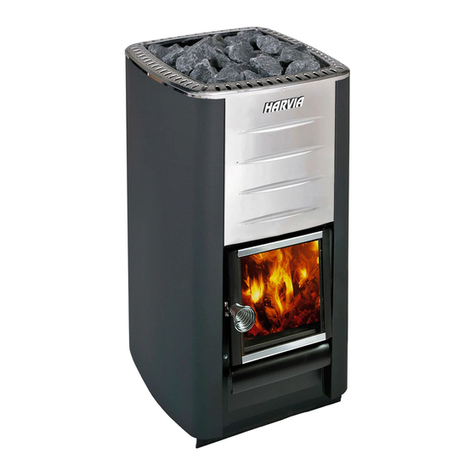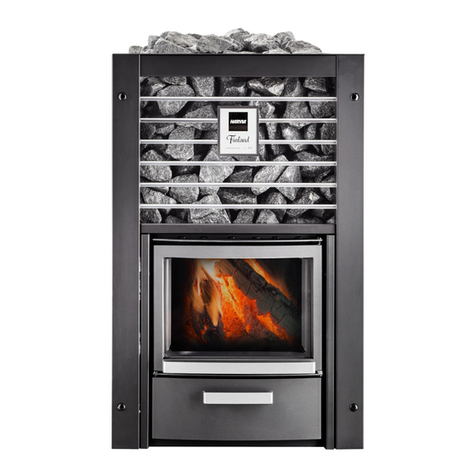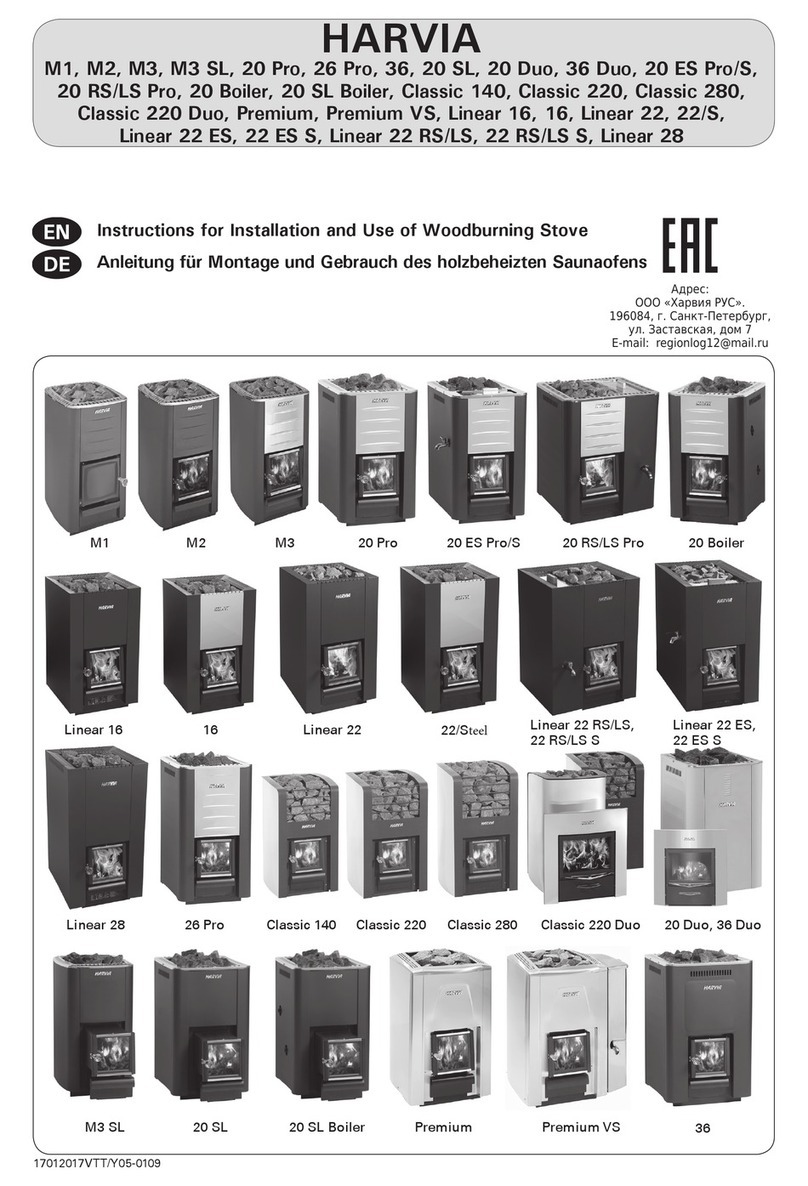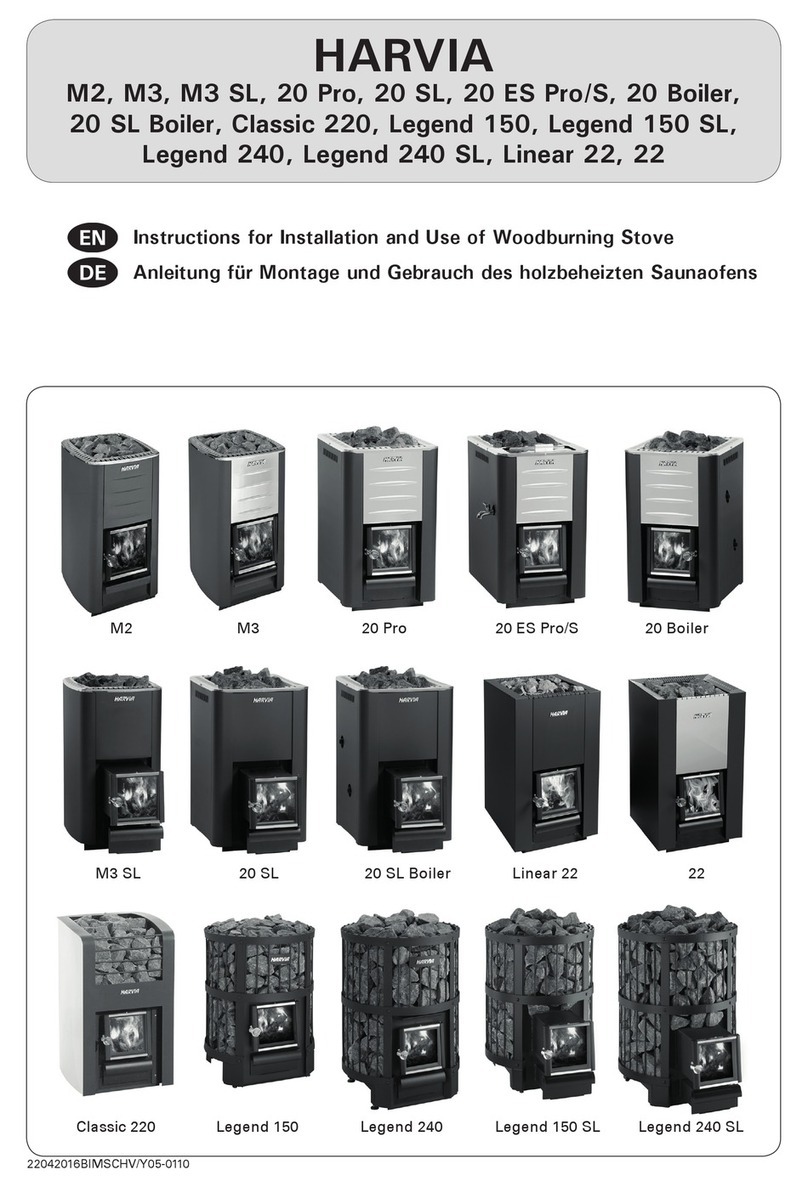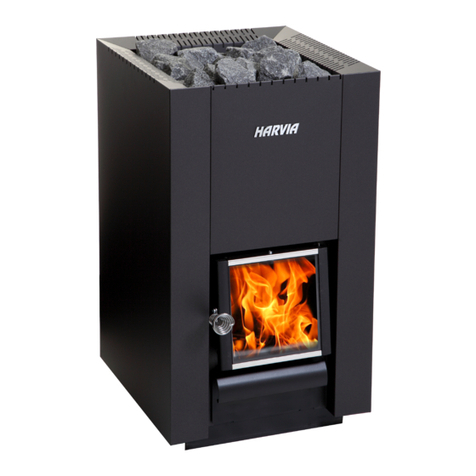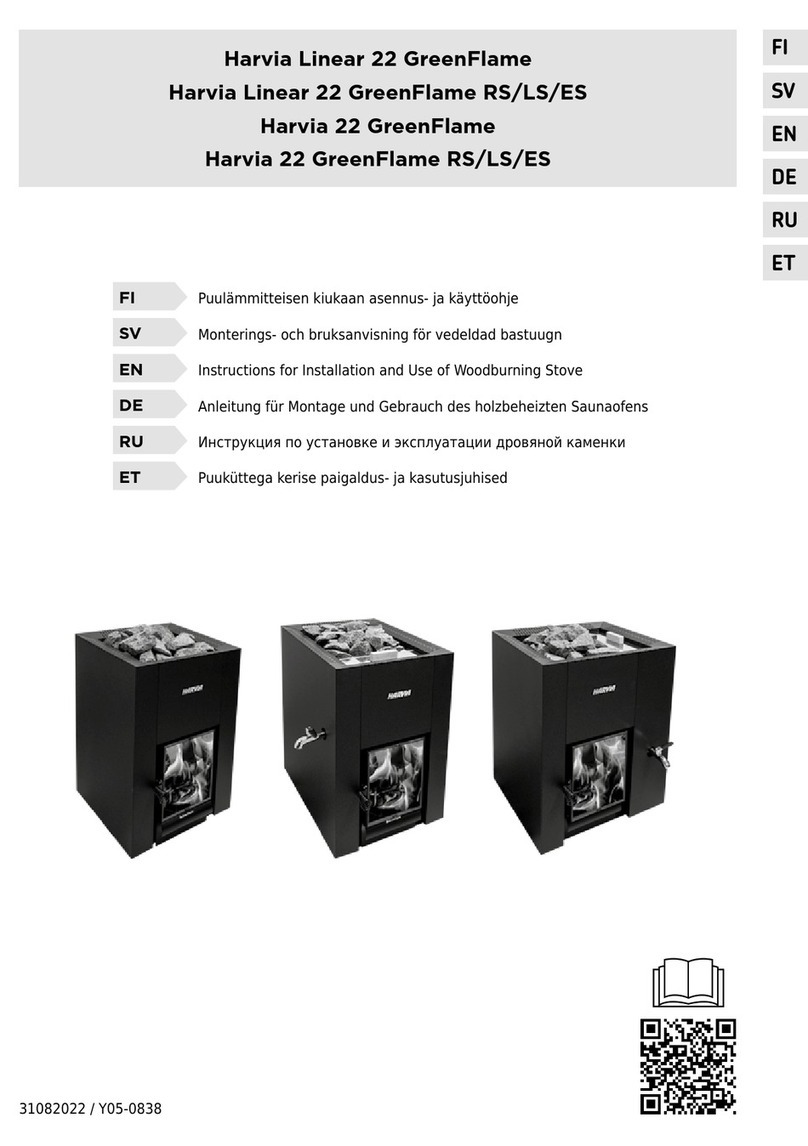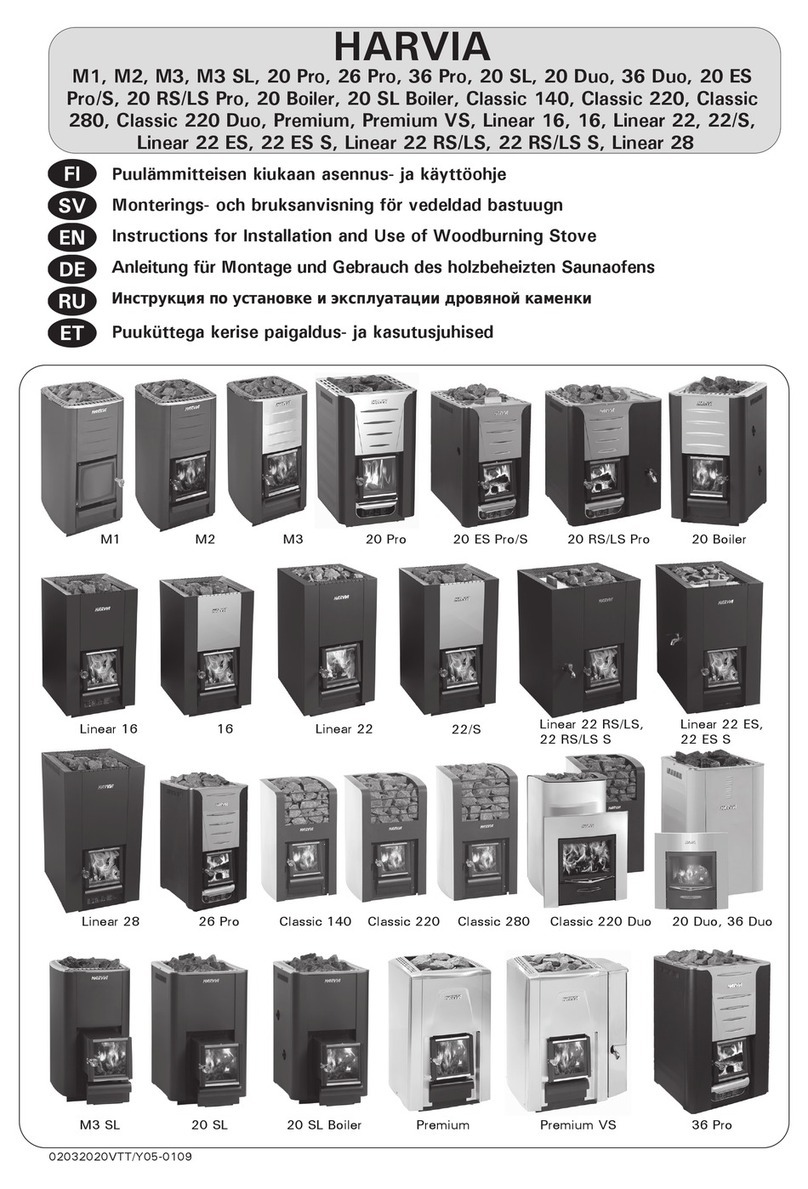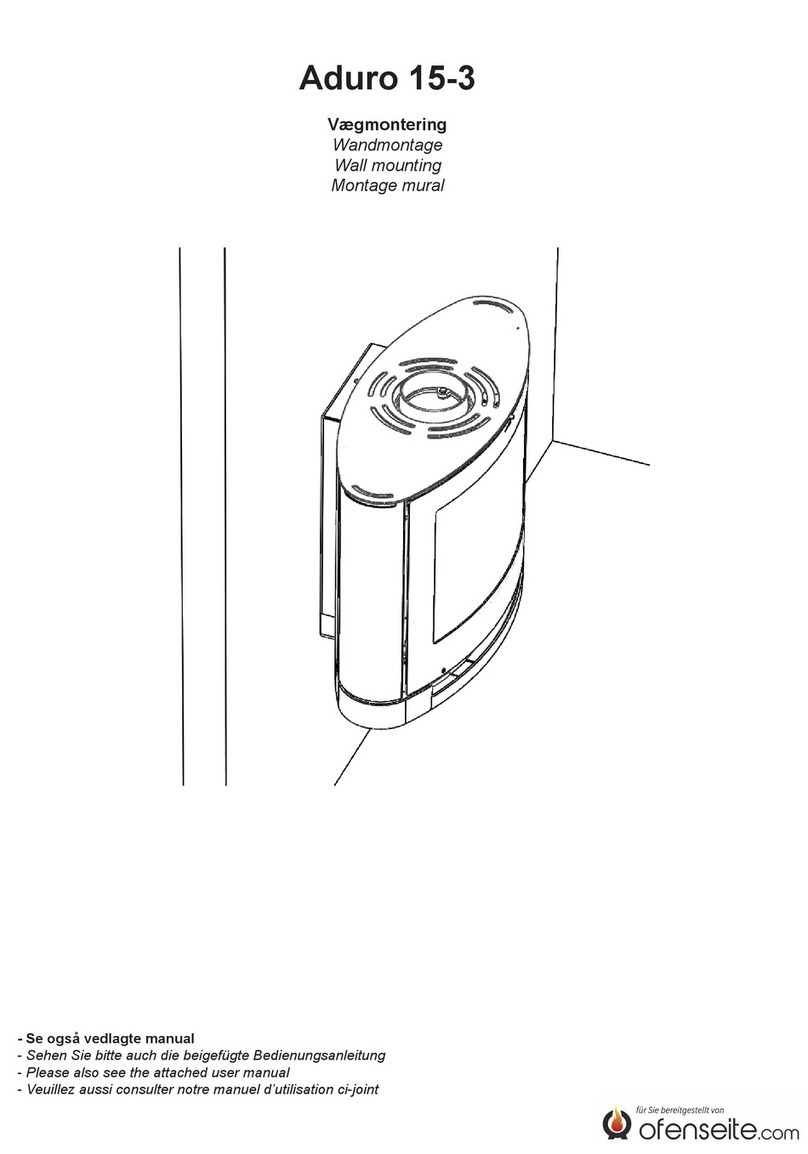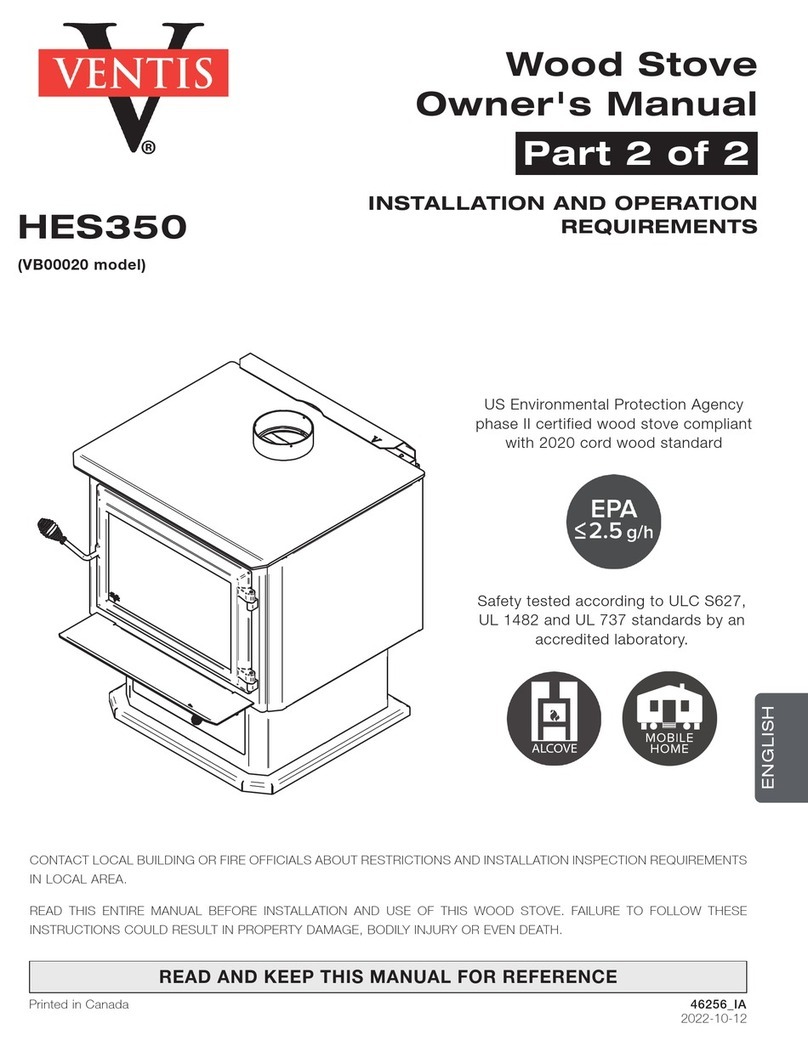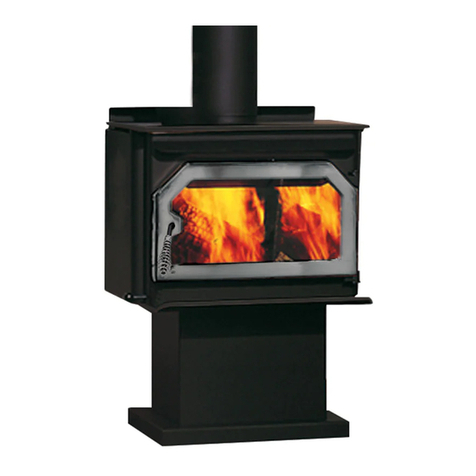EN DE
9
humus content <12 mg/litre
iron content <0.2 mg/litre
calcium content <100 mg/litre
manganese content <0.05 mg/litre
2.7. Stove Maintenance
The ash box should always be emptied before
heating the stove so that the combustion air
that is lead through the box would cool off the
fire grate and lengthen its life span. Get a metal
container, preferably standing model, to put the
ash in. As the removed ash may include hot
embers, do not keep the ash container close to
combustible material.
Soot and ashes gathered in the smoke canals
of the stove should be removed occasionally
through the soot openings ( 1.2.).
The chimney should be swept at regular
intervals to ensure sufficient draught.
Due to large variation in temperature, the
sauna stones disintegrate in use. Therefore,
they should be rearranged at least once a year
or even more often if the sauna is in frequent
use. At the same time, any pieces of stones
should be removed from the stone space, and
disintegrated stones should be replaced with
new ones.
Wipe dust and dirt from the stove with a damp
cloth.
2.8. Troubleshooting
There is no draught in the flue. Smoke comes into
the sauna.
There are leaks in the flue connection. Seal the
connection ( 4.2.2.).
The brick flue is cold.
There is low pressure caused by an extractor
fan or another device in the room. Make sure
there is enough air to compensate.
Several fireplaces are used at the same time.
Make sure there is enough air to compensate.
The ash box is full.
The smoke canals of the stove are blocked ( 2.7.).
The flue connection pipe is too deep in the
chimney ( 4.2.2.).
The sauna does not heat up.
The sauna is too big in relation to the stove’s
heating capacity ( 1.1.).
There is lots of non-insulated wall surface in
the sauna ( 1.1.).
You can speed up the heating process by
removing the combustion air channels ( 1.3.).
The burning material is moist or its quality is
otherwise low ( 2.3.).
The flue does not have a good draught.
The smoke canals of the stove are blocked ( 2.7.).
The stove stones do not heat up.
The flue does not have a good draught.
The burning material is moist or its quality is
otherwise low.
The smoke canals of the stove are blocked ( 2.7.).
Check the stone placement ( 2.4.).
The stove emits smell.
See section 2.2.
The hot stove may emphasize odours mixed in
the air that are not, however, caused by the
sauna or the stove. Examples: paint, glue, oil,
seasoning.
•
•
•
•
•
•
•
•
•
•
•
•
•
•
•
•
•
•
•
•
•
•
•
•
•
•
•
•
Humusgehalt <12 mg/Liter
Eisengehalt <0,2 mg/Liter
Kalziumgehalt <100 mg/Liter
Mangangehalt <0,05 mg/Liter
2.7. Wartung des Ofens
Der Aschekasten sollte vor jedem Heizen des
Ofens geleert werden, damit die Verbrennungs-
luft, die durch den Aschekasten geführt wird,
den Feuerrost kühlt und dessen Lebensdauer
verlängert. Verwenden Sie einen Metallbehäl-
ter, vorzugsweise ein stehendes Modell, für die
Asche. Da sich heiße Glutstücke in der Asche
befinden können, halten Sie den Aschebehälter
von brennbaren Materialien fern.
Ruß und Asche, die sich in den Rauchkanälen
des Ofens sammeln, müssen gelegentlich durch
die Rußöffnungen entfernt werden ( 1.2.).
Der Rauchfang muss regelmäßig gefegt wer-
den, um einen ausreichenden Zug zu sichern.
Aufgrund der großen Wärmeänderungen werden
die Saunasteine spröde und brüchig. Die Steine
sollten mindestens einmal jährlich neu aufge-
schichtet werden, bei starkem Gebrauch öfter.
Bei dieser Gelegenheit entfernen Sie bitte auch
Staub und Gesteinssplitter aus dem unteren Teil
des Saunaofens und ersetzen beschädigte Steine.
Staub und Schmutz vom Ofen mit feuchtem
Tuch abwischen.
2.8. Störungen
Im Rauchfang findet kein Luftzug statt. Es tritt
Rauch in die Sauna.
Es gibt undichte Stellen im Anschluss des Rauch-
fangs. Dichten Sie den Anschluss ab ( 4.2.2.).
Der gemauerte Rauchfang ist kalt.
Ein Sauglüfter oder ein anderes Gerät im Raum
führt zu einem Niederdruck. Sorgen Sie im Aus-
gleich für genügend Luft.
Es werden mehrere Feuerstellen gleichzeitig ge-
nutzt. Sorgen Sie im Ausgleich für genügend Luft.
Der Aschekasten ist voll.
Die Rauchkanäle des Ofens sind verstopft ( 2.7.).
Das Abzugsanschlussrohr darf nicht zu weit in
den Rauchfang hineinreichen ( 4.2.2.).
Die Sauna wird nicht warm.
Die Sauna ist in Relation zur Heizkapazität des
Ofens zu groß ( 1.1.).
Es gibt viele nicht isolierte Wandoberflächen in
der Sauna ( 1.1.).
Sie können das Aufheizen beschleunigen, indem
Sie die Verbrennungsluftkanäle entfernen ( 1.3.).
Das Brennmaterial ist feucht oder anderweitig
von schlechter Qualität ( 2.3.).
Der Rauchfang hat keinen guten Luftzug.
Die Rauchkanäle des Ofens sind verstopft ( 2.7.).
Die Saunaofensteine werden nicht warm.
Der Rauchfang hat keinen guten Luftzug.
Das Brennmaterial ist feucht oder anderweitig
von schlechter Qualität.
Die Rauchkanäle des Ofens sind verstopft ( 2.7.).
Überprüfen Sie die Anordnung der Steine ( 2.4.).
Der Ofen gibt Gerüche ab.
Siehe Abschnitt 2.2.
Ein heißer Ofen kann Gerüche in der Luft ver-
stärken, die jedoch nicht durch die Sauna oder
den Ofen selbst verursacht wurden. Beispiele:
Farbe, Klebstoff, Öl, Würzmittel.
•
•
•
•
•
•
•
•
•
•
•
•
•
•
•
•
•
•
•
•
•
•
•
•
•
•
•
•



